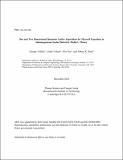| dc.contributor.author | Vahala, George | en_US |
| dc.contributor.author | Valhala, Linda | en_US |
| dc.contributor.author | Soe, Min | en_US |
| dc.contributor.author | Ram, Abhay K. | en_US |
| dc.date.accessioned | 2025-03-21T20:20:00Z | |
| dc.date.available | 2025-03-21T20:20:00Z | |
| dc.date.issued | 2020-12 | |
| dc.identifier | 20ja104 | |
| dc.identifier.uri | https://hdl.handle.net/1721.1/158685 | |
| dc.description | Submitted for publication in Radiation Effects and Defects in Solids | |
| dc.description.abstract | A quantum lattice algorithm (QLA) is developed for Maxwell equations in scalar dielectric media using the Riemann-Silberstein representation on a Cartesian grid. For x-dependent and y-dependent dielectric inhomogeneities, the corresponding QLA requires a minimum of 8 qubits/spatial lattice site. This is because the corresponding Pauli spin matrices have off-diagonal components which permit the local collisional entanglement of these qubits. However, z-dependent inhomogeneities require a QLA with a minimum of 16 qubits/lattice site since the Pauli spin matrix σz is diagonal. For 2 dimensional inhomogeneities, one can readily couple the 8-8 qubit schemes for x-y variations. z-x and y-z variations can be treated by either a 16-8 qubit scheme or a 16-16 qubit representation. | |
| dc.publisher | Taylor & Francis | en_US |
| dc.relation.isversionof | doi.org/10.1080/10420150.2021.1891058 | |
| dc.source | Plasma Science and Fusion Center | en_US |
| dc.title | One and Two Dimensional Quantum Lattice Algorithms for Maxwell Equations in Inhomogeneous Scalar Dielectric Media I: Theory | en_US |
| dc.type | Article | en_US |
| dc.contributor.department | Massachusetts Institute of Technology. Plasma Science and Fusion Center | |
| dc.relation.journal | Radiation Effects and Defects in Solids | |
